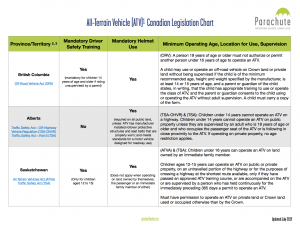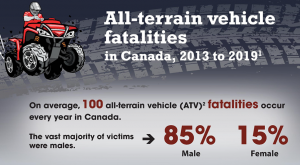All-terrain vehicles (ATVs), also known as quads, are powerful machines that require strength and skill to operate. Riding safely and responsibly can help prevent serious injury and death on these vehicles.
61 per cent of Canadians say they have ridden an ATV at least once and 15 per cent report riding frequently, according to a national survey conducted by Parachute and Ipsos.
According to Statistics Canada:
- On average, there are 100 ATV-related deaths in Canada each year.
- 85 per cent of victims in ATV-related deaths are male.
- Most ATV-related deaths result from a rollover or flip. Other top causes include collisions with other vehicles or objects and being ejected from the vehicle.
- Half of ATV-related deaths involve alcohol or drugs.
Ride safe, ride responsibly, ride on
- Take an ATV training course, such as from the Canadian ATV Safety Institute.
- Wear protective gear every ride, including eye protection, gloves, boots, long-sleeved shirt and long pants.
- Wear a helmet that is up to the standard recommended for motorcycles. The U.S. Consumer Product Safety Commission found that helmet use could reduce the risk of ATV non-fatal head injuries by 64 per cent and risk of death by 42 per cent.
- Control your speed. Excessive speed is a major risk factor for ATV-related deaths.
- Always ride sober. Avoid driving after consuming alcohol or drugs.
- Ensure that the ATV is appropriately sized for the rider(s). Both operators and passengers should be able to simultaneously reach their foot pegs, grasp their handles and sit down fully in their seats. Operators should additionally be able to comfortably reach and operate all ATV controls.
- Follow manufacturer instructions for proper ATV use and maintenance.
Respect passenger limits
- Never carry passengers on an ATV designed for one rider.
- Never carry more passengers than the ATV is designed for. Check the manufacturer instructions and the number of seats on the vehicle.
- If driving with passengers, drive with great care, particularly with children who may have difficulty holding on during sudden turns, or on bumpy roads. It is critical that child passengers are able to simultaneously reach the foot pegs, grasp the handles and sit down fully in the seat.
- Check the laws in your province or territory for minimum age requirements for passengers.
Ride only where ATVs are meant to go
- Ride on designated trails.
- Stay off paved roads and highways: ATVs are not designed to travel on pavement. Cross roads safely, where permitted.
- Avoid riding on steep hills.
- Be aware of changing weather and trail conditions and respect the environment around you. Make sure you can see your environment and can respond in time to avoid objects, people, trees and other hazards.
Children and youth are at special risk
ATV use by children has resulted in serious injury and death. Children and youth lack the knowledge, development and skills to safely operate these vehicles.
Parachute recommends a minimum age of 12 to ride an ATV as a passenger, a minimum age of 14 to operate an ATV under the supervision of an adult who is within clear sight of the rider and a minimum age of 16 to operate an ATV without supervision and to carry a passenger who is younger than 18.
Parents/caregivers and riders should consult their local laws regarding age restrictions.

